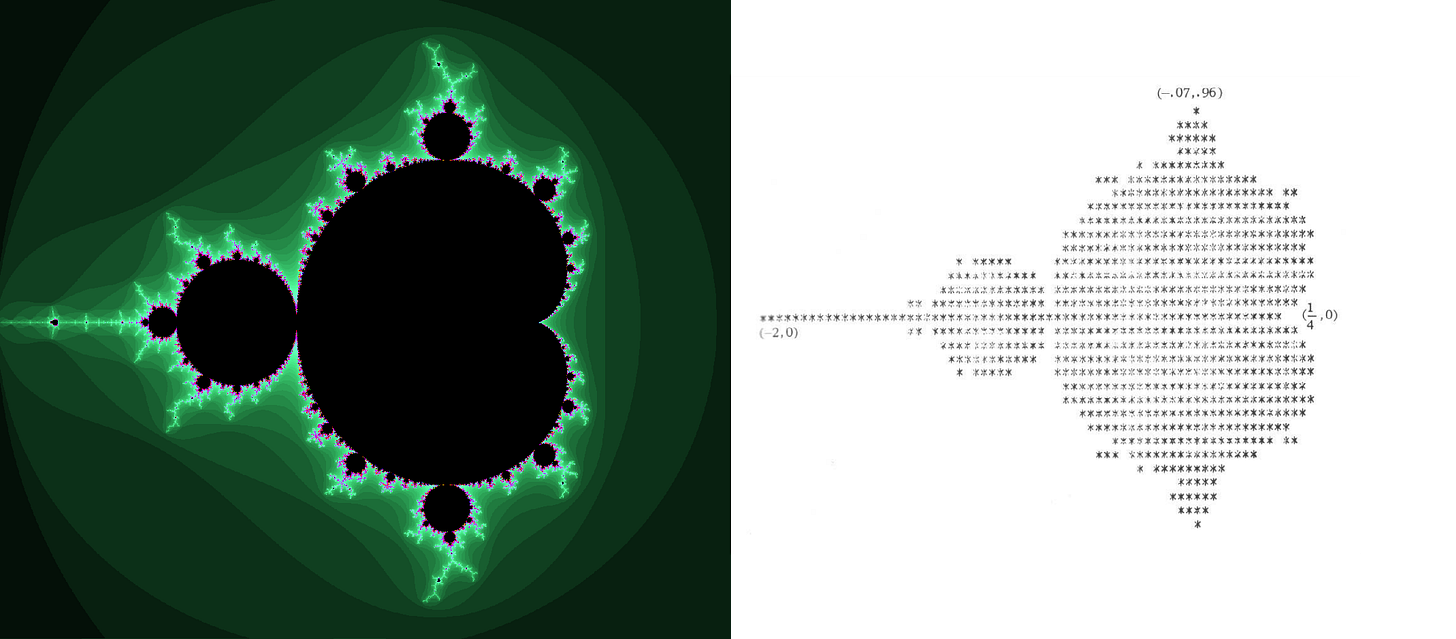Unmasking Chaos
What are the differences between chaos and random noise? Does untangling complexity mean getting rid of chaos? And what aspects of chaos can be predictable, useful, or even beautiful?
Chaos is a word that usually evokes images of disorder and confusion. At first glance, it appears to be the opposite of structure and order, but upon closer examination, we discover that chaos is not always a random rustle. We often call chaos a phase of a system where the amount of information becomes so intense that it surpasses our perceptual capacity and resembles noise. This is not the absence of order, but sometimes rather its extreme form.
When you think, for example, of a living city and inspect its pulse, you can see some regularities, periodicity, or patterns, but not all of them. You miss the context. You have no idea how the city works because it’s a dynamic system of individual trajectories of everybody and everything there. But if you could understand everyone’s path, the chaos would slightly shift toward order. One step closer but still missing information hidden deeper in the minds of every individual to understand the motivations and processes behind their decisions. Then another step. Their brains, the atoms they are made of, go down and down until you ultimately end up at a dead end of physics, with God or some other level of uncertainty. There will always be a little unknown left, but you will see many symmetrical patterns and self-similarities on the way.
This resemblance of chaos starts at the threshold of predictable structure towards unpredictable complexity. It is ultimately the level of order that transcends our simulation capabilities, meaning predicting the future state of such a system is impossible.
However, there is another notion of chaos. It starts with simplicity, and its essence generates the complexity all around us.
The Essence of Deterministic Chaos
I spent several years commuting by train, traveling to and from school for three hours daily. The journey took me through diverse landscapes and lush forests, where I often admired the intricate shapes crafted by nature. As I spent so much time looking out the window, I began to understand that the repetitive complexity of the structures I saw likely stemmed from something fundamentally simple. This reflection led me to uncover the concept of chaos and the fractal essence of nature. Later on, I studied the work of A. Lyapunov, R. Elliot, or E. Lorenz, and applied concepts of chaos theory in my thesis.
Let’s unveil the mathematical theory of chaos1. It describes non-linear systems that are highly sensitive to initial conditions, where even a minor change can lead to drastically different outcomes. It’s the profane butterfly effect.
Thanks to this sensitivity, a system can start behaving in a way that resembles randomness, but it is deterministic in the sense that it is formally defined, does not contain any random parameters, and if you start with the exact same initial conditions, you will get the exactly same behavior every time.
Even deterministic chaos poses a considerable challenge. You might think that since it is deterministic, it should be manageable with numerical methods. One hallmark of chaotic systems is their high dimensionality. That, in combination with a vast number of possible states, means these systems can shift between various stable configurations through what appears to be random fluctuations, significantly complicating simulations.
A good example is one of the early problems of celestial mechanics and the founding pillars of chaos theory. The Poincaré’s three-body problem. Its idea is to calculate and predict trajectories of three bodies interacting through gravitational force (e.g. three-star solar system) using Newton’s law of universal gravitation. Let me demonstrate the trajectories of these three bodies for you2:
All the bodies have the same mass, zero initial velocities, and only marginal differences in initial vector positions. The rest is done by gravity. This chaotic behavior comes out of three second-order differential equations that don’t have a general analytical solution and are entirely computed numerically.
Obviously, chaos can also appear in something as precise and deterministic as mathematics.
Fabric of Reality
Now, we understand both notions of chaos. One represents overwhelming complexity, limited only by perception, and the other generates complexity out of simplicity. You surely feel they’re intertwined, and perception and computational capabilities are the keys to their common nature.
Chaotic systems are all around us and shape the reality as we know it. At one end of the spectrum lie simple systems with minimal information – for instance, a mathematical pendulum whose motion can be easily described and predicted. But even Earth’s spin will eventually turn the physical pendulum into a chaotic system.
At the other end are systems containing so many variables and interactions that even the most advanced models can only partially describe them or find limited solutions even for their mathematical representations. Climate, population dynamics, economics3, or even rhythms in biological processes may seem unpredictable, but they have underlying chaos principles at their core.
One notably challenging problem due to its complexity is fluid dynamics. You can imagine it as if you were looking out the window during a snowfall. You can see each snowflake floating beautifully on its unique path; some twirl gracefully with the wind, while others pause for a moment, almost as if they’re enjoying the view before being whisked away again. To truly grasp their behavior, we need an intricate model known as the Navier-Stokes equations. While these equations may explain a lot, they remain an unsolved mathematical problem and keep the prize of one million dollars waiting to be collected.4
Self-Similarity and Expanding Symmetry
Historically, many mathematicians noticed that iterating on simple formulas in a complex plane could quickly generate unprecedented complexity, and when visualized, actual chaos could be seen! But all early attempts to draw this complexity failed. One of the simplest formulas is
Yes, it is the most famous one—the Mandelbrot set prescription. How does it work? The sequence must not escape to infinity for a complex number c to belong to the Mandelbrot set. Let me show you. Let’s set the initial value of c to a proven constant, like
It is a simple real number within the set, and its sequence converges instead of diverging. Now, to render the first few points in this set without a computer, you would go through this manual exercise:
As you can see, you need very precise decimal point arithmetic just to calculate the first four points. During each iteration, you must check whether the complex number c belongs to the set or not by examining the magnitude (absolute value) of zₙ against this condition:
If |zₙ| is greater than 2, the sequence diverges to infinity, meaning the c value is not in the Mandelbrot set M. It belongs to the set if |zₙ| is less than or equal to 2.5 This binary distinction tells us the basic representation of the point when rendered.
Let’s use asterisks (*) for points in the set and dashes (-) for points outside the set as Benoît Mandelbrot did in the 1980s when he rendered probably the very first Mandelbrot set using a computer6. After hours of patient waiting, the result in the form of a vaguely ass-shaped blob finally appeared:
This grainy, low-resolution render was a doorway to a world of infinite beauty, where math and art collide—a world of fractals.
Let’s Travel Together!
If you’re curious about what the Mandelbrot fractal may look like today, I wrote a web app allowing you to travel the set. It is limited by the threshold of the 32-bit floating-point arithmetic in your GPU’s fragment shader and can’t go very far, but you can still explore some of the intricate structures. It also contains Julia mode to explore Julia fractal.
Mandelbrot set is a set of all Julia sets. Every Julia set can be defined by a point in the Mandelbrot set matching its constant c value.
The pseudocode of the main method is very simple7:
def mandelbrot(c, max_iterations):
z = 0
for n in range(max_iterations):
z = z**2 + c
if abs(z) > 2:
# Normalize the escape value for smooth coloring
return n + 1 - np.log2(np.log2(abs(z)))
return max_iterationsThe values are normalized to achieve fancy coloring (faster escape = brighter colors, slower escape = darker colors). The app allows you to randomize the color palette, and I have also preprogrammed a few interesting zoom-ins you can admire. Let me know your thoughts, or share some of your zoom-ins!
Tip: Zooming out the Mandelbrot set reveals the surrounding circle with a diameter of 2 that encloses the entire set.
Compare the difference. Medieval mathematicians could only imagine a few points. In his first render, Mandelbrot saw a few hundred points of the set on a print corresponding to the two orders of magnitude. My app can do seven orders of magnitude before it pixelates. The best fractal zoomers can render the set at more than 20,000 orders of magnitude. Computing power allows us to push the limits and delve into previously hidden structures and patterns of chaos.
But Where Is The Chaos, Exactly?
With increasing precision and the number of iterations, we discover sets of points that do not change their behavior very often during the calculation but also sets of points that are very sensitive to changes. The boundaries between them create the fractals. That’s why the Mandelbrot set has a distinctive shape, and the Julia set changes its look rapidly with a small change of the c at certain points. It is always the coastline where fractal shapes appear.
Fractals are, therefore, another example of deterministic chaos. Even a simple equation can generate unpredictable complexity, yet it is always the same. Fractal geometry reveals that even seemingly disordered structures contain recurring patterns. Discovering its existence transformed my previous commuting insights into a genuine passion. Fractal shapes can be found in tree growth, cloud formations, river flows, or Romanesco broccoli, forming the world around us.
“My life seemed to be a series of events and accidents. Yet when I look back, I see a pattern.” (B. Mandelbrot)
World Without Chaos
Although chaos may initially appear negative, you just learned that it is, in fact, an indispensable source of innovation and change. Systems that are overly rigid and orderly can easily become stagnant. Chaos introduces diversity, new possibilities, and unexpected connections. In evolution, chaos drives adaptation and the emergence of new species. Without it, humankind would probably not exist.

Chaos provides a space for new ideas and perspectives. It challenges us to think beyond the confines of established patterns and explore uncharted territories of thought and imagination. Psychedelic hallucinations often present themselves in fractal shapes, reflecting the structure of our brains and our thoughts.
Chaos forces us to confront the nature of our existence. It blurs the boundary between determinism and free will, suggesting that the universe is a dynamic interplay of patterns and unpredictability at the verge of our perception. In chaos, we find a mirror of human life itself: an intricate balance between order and spontaneity.
Chaos is the force that drives creation and destruction, order and disorder. It shows us that the world is not black and white but full of shades waiting to be understood.
Thank you for reading! If you want to learn more about how chaos affects the world around us, what role prime numbers play in shaping reality, or more about fractals, subscribe for free to receive new posts and support my work.
Chaos Theory Definition by Britannica Encyclopedia
I also used a few bits of chaos theory in my diploma thesis to predict stock market prices.
The biggest problem is finding smooth solutions to the equations.
Why 2? Because the whole Mandelbrot set lies within the boundaries of a circle with a diameter of 2, which is the greatest number you can subtract from its square and have a difference <= that number.
B. Mandelbrot at IBM. I also recommend the paper from Brooks and Matelski.








![Záznam 2025-01-25 214916.mp4 [video-to-gif output image] Záznam 2025-01-25 214916.mp4 [video-to-gif output image]](https://substackcdn.com/image/fetch/$s_!9c1F!,w_1456,c_limit,f_auto,q_auto:good,fl_lossy/https%3A%2F%2Fsubstack-post-media.s3.amazonaws.com%2Fpublic%2Fimages%2Feb72bc28-c97a-48cc-bf97-c06c432fdfd3_800x524.gif)



https://tenor.com/en-GB/view/jurassic-park-ian-malcolm-jeff-goldblum-there-it-is-gif-4674754